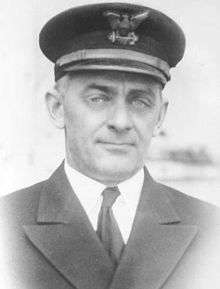Elmer Fowler Stone
| Elmer Fowler Stone | |
|---|---|
 Commander Elmer Fowler Stone | |
| Born |
1887 Livingstone, New York |
| Died | 1936 (aged 48–49) |
| Allegiance | United States of America |
| Service/branch | United States Coast Guard |
| Years of service | 1910-1936 |
| Rank | Commander |
| Awards |
Navy Cross NC-4 Medal Air Force Cross (UK) |
Elmer "Archie" Fowler Stone (January 22, 1887 - May 20, 1936) was a United States naval aviator and a commander in the United States Coast Guard.
Biography
Stone was born in Livingstone, New York and grew up in Norfolk, Virginia. He joined the U.S. Revenue Cutter Service in 1910.
Elmer Stone was a United States Coast Guard aviation pioneer; in early 1915 Stone and another officer Norman B. Hall, were the first to suggest that the Coast Guard develop an aviation capability. With the encouragement of their commanding officer, Captain Benjamin M. Chiswell of the USRC Onondaga, Lieutenants Stone and Hall approached the Curtiss Flying School in Newport News, Virginia about using aircraft in air-sea rescue operations, and participated in experimental flights in a Curtiss model F flying boat. During the summer of 1915, Stone and Hall performed scouting patrols for Onondaga, assisting in search missions that the cutter was assigned.[1] In 1916 he was trained in aircraft use at the United States Navy flight facility in Pensacola, Florida, and also studied aeronautical engineering at the Curtiss factory. On April 10, 1917, Stone became the Coast Guard's first aviator upon graduating from flight training at Pensacola and was appointed as Coast Guard Aviator No. 1 and Naval Aviator No. 38.
In May 1919 First Lieutenant Elmer F. Stone was the pilot on the first successful transatlantic flight on NC-4 with Lieutenant Commander A. C. Read, USN, the mission commander and navigator. After the historic flight, he was awarded the British Air Force Cross by the British government (June 9, 1919), and received a promotion to the temporary rank of captain on 25 September 1919. He was awarded the Navy Cross and Congressional Medal of Achievement for "distinguished service in making the first successful trans-Atlantic flight" on November 11, 1920.
For the next six years he worked with the Navy's Bureau of Aeronautics where he assisted in the development of the catapults and arresting gear of the new aircraft carriers USS Lexington and USS Saratoga, equipment still used on aircraft carriers to this day. He continued to promote aviation in the U.S. Coast Guard during the 1920s, He collaborated with the Curtiss Aeroplane and Motor Company on development of airborne "motor lifeboats" for the explicit purpose of lifesaving missions, and in this is one of the pioneers of modern air-sea rescue. He also commanded a former destroyer that was turned over to the U.S. Coast Guard and used in the enforcement of Prohibition.
After a tour at sea, Stone became the commanding officer of the Coast Guard Aviation Unit at Cape May, New Jersey, where he continued to develop his skill at making open-ocean landings. In 1933 Stone put his open-ocean landing skills to the test when the Navy dirigible Akron went down off the Atlantic coast in a storm with only three survivors of the 76 aboard, Stone was the only pilot available willing to attempt a landing in the heavy seas. He accomplished this successfully, but was too late to save any more lives. On December 20, 1934, he broke the world seaplane speed record, 191 miles per hour over a 3 kilometer test course.
Commander Stones' last duty was as the commanding officer of the Air Patrol Detachment in San Diego. He died of a heart attack while on duty on May 26, 1936, while inspecting a new aircraft and was buried in Arlington National Cemetery. Stone was a pivotal figure in the establishment and development of aviation for the Coast Guard and the Navy and was a favorite of many of the famous aviation figures of the day, including Eddie Rickenbacker, aircraft designers Anthony Fokker, Igor Sikorsky, and Alexander P. de Seversky.
Commander Elmer "Archie" Stone was inducted into the United States Naval Aviation Hall of Honor on May 5, 1983, and is also a member of the U.S. Coast Guard Aviation Hall of Fame.
Notes
- Citations
- ↑ Evans, p 188
- "Commander Elmer Fowler Stone". United States Coast Guard web site. Retrieved 2008-06-14.
- "Official orders, correspondence and documents related to E. F. Stone's aviation career" (PDF). United States Coast Guard web site. Retrieved 2006-12-15.
- References used
- Evans, Stephen H. (1949). The United States Coast Guard 1790–1915: A Definitive History. Naval Institute Press, Annapolis, Maryland.
- Thiesen, Ph.D., William H. (April 2010). "Elmer F. Stone '13 and the Pioneering Role of Coast Guard Academy Graduates in Early Naval and Coast Guard Aviation" (pdf). USCG.mil. The Foundation for Coast Guard History. Retrieved 2016-05-11.
External links
- U.S. Coast Guard web site - Aviation History index
- Chronology of Coast Guard Aviation history
- Elmer Fowler Stone at Find a Grave